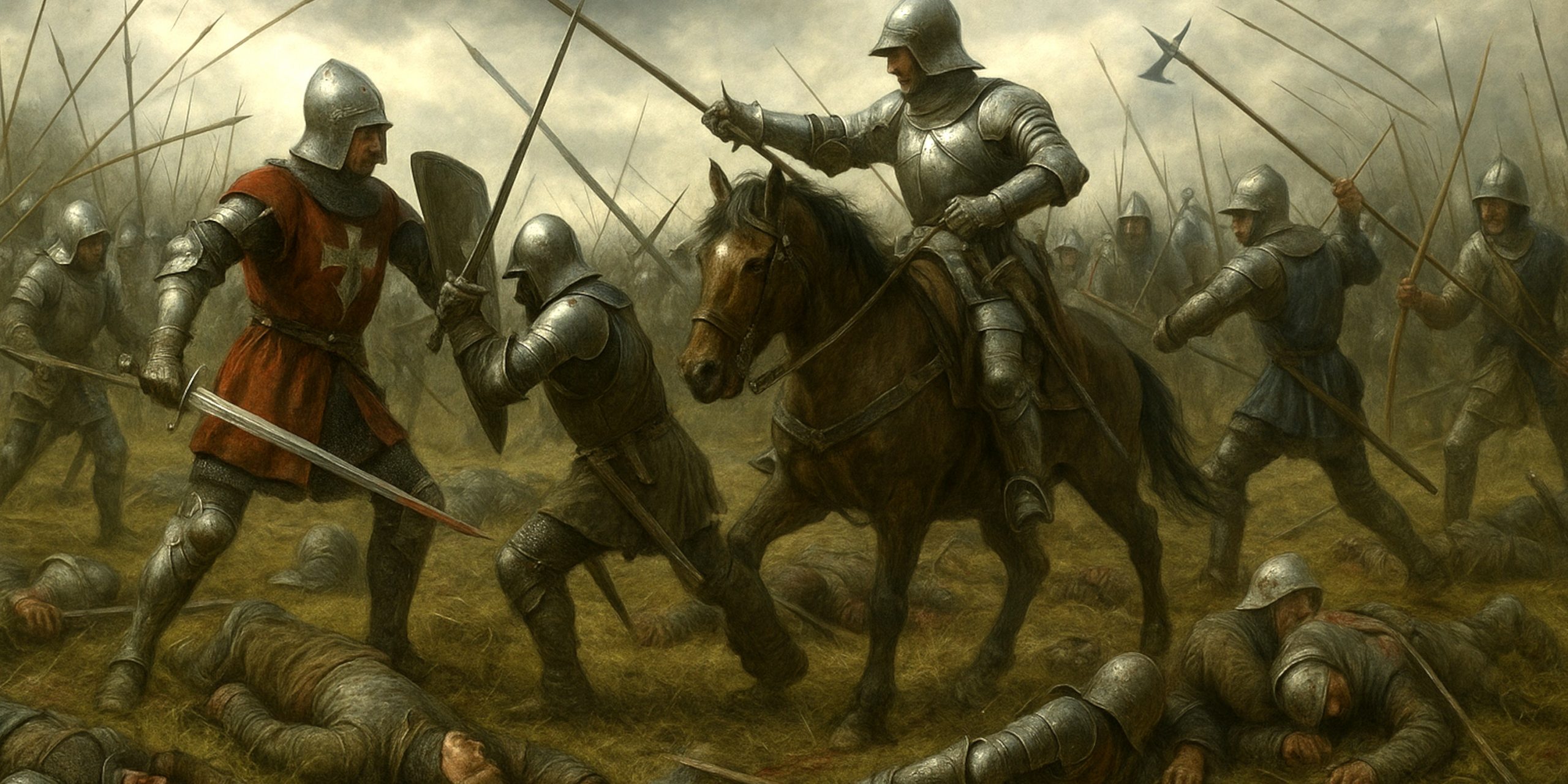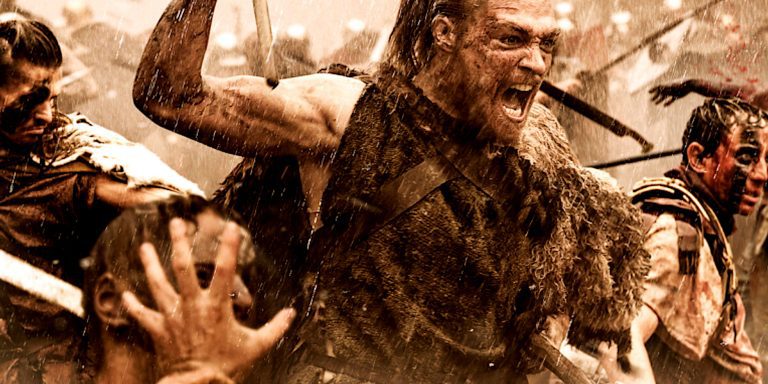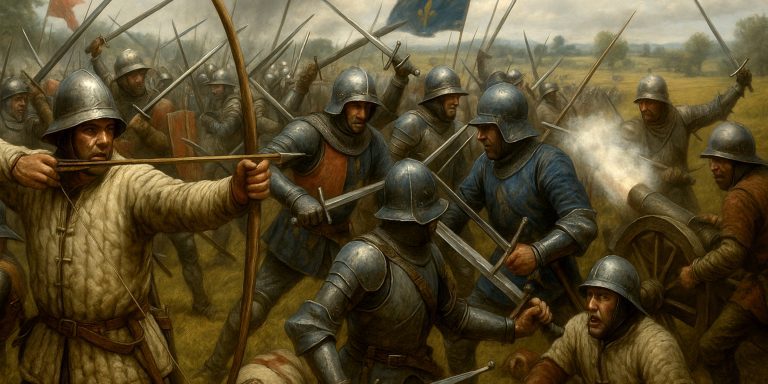
The Battle of Blore Heath, fought on 23 September 1459, was one of the early engagements of the Wars of the Roses. It took place near Market Drayton in Shropshire and saw the Yorkist forces under Richard Neville, Earl of Salisbury, defeat a much larger Lancastrian army. Despite the victory, the Yorkist cause faced significant setbacks in the months that followed.
Background
By 1459, tensions between the Yorkist faction, led by Richard, Duke of York, and the Lancastrian loyalists of King Henry VI had reached breaking point. Queen Margaret of Anjou, determined to secure her son’s succession, began gathering loyalist forces. The Earl of Salisbury was marching south to join York at Ludlow when he was intercepted near Blore Heath by a Lancastrian army commanded by James Touchet, Lord Audley.
Forces
The armies at Blore Heath were unequal in size. Lord Audley commanded a strong Lancastrian host, while Salisbury’s Yorkist force was outnumbered but better disciplined.
| Side | Commander | Estimated Strength | Composition |
|---|---|---|---|
| Yorkists | Richard Neville, Earl of Salisbury | c. 5,000 | Men-at-arms, billmen, archers |
| Lancastrians | James Touchet, Lord Audley | c. 10,000 | Men-at-arms, billmen, archers, cavalry |
Arms and Armour
Both sides fielded typical mid-15th century English weaponry and protection.
Common Weapons:
- Longbows, forming the backbone of the infantry
- Bills and polearms for close combat
- Swords and daggers for sidearms
- Cavalry lances for mounted charges
Armour:
- Plate harness for nobles and men-at-arms, often with sallet helmets
- Brigandines and mail for lower-ranking soldiers
- Padded jacks for lightly equipped levies
Primary sword types present would likely have included:
For Men-at-Arms and Nobility:
- Arming Sword – The single-handed, straight, double-edged sword that was still the standard knightly weapon. Often paired with a buckler or used alongside a lance or polearm.
- Longsword – Increasingly popular among higher-ranking men-at-arms, offering greater reach and the ability to use two hands for more powerful strikes.
- Bastard Sword (Hand-and-a-Half) – Favoured for its versatility, allowing either one- or two-handed use depending on whether the wielder was mounted or dismounted.
For Common Infantry:
- Falchion – A single-edged sword with a heavy cutting blade, valued for its ability to cleave through lighter armour and cause devastating wounds.
- Hanger or Short Sword – A compact, easily carried sidearm, often used by archers and billmen as a backup weapon.
- Baselard Dagger – Worn by soldiers of all classes for close-quarters combat and as a utility blade.
Battlefield Context:
While swords were status symbols and effective in close combat, the bulk of the killing power at Blore Heath came from longbows and polearms such as bills and glaives. Swords were more often drawn when formations broke or in the press of melee. Wealthier soldiers would have invested in well-made blades, while common levies carried simpler, more rugged versions.
Leaders and Troop Composition Table:
| Leader | Side | Role | Notable Troops |
|---|---|---|---|
| Richard Neville, Earl of Salisbury | Yorkist | Overall commander | Archers, dismounted men-at-arms |
| James Touchet, Lord Audley | Lancastrian | Overall commander | Heavy cavalry, billmen |
| Lord Dudley | Lancastrian | Senior commander after Audley | Infantry, archers |
The Battle
Salisbury, aware of his numerical disadvantage, took up a defensive position behind a brook. He placed his archers at the front and used the terrain to protect his flanks. Lord Audley attempted to break the Yorkist line with a direct cavalry assault, but the charge was met with concentrated longbow fire.
Audley was killed early in the fighting, which damaged Lancastrian morale. Lord Dudley took command and pressed the attack, but repeated assaults failed to dislodge the Yorkists. Eventually, Salisbury’s men counter-attacked, forcing the Lancastrians to retreat.
Archaeology
The battlefield area has seen limited archaeological investigation. Metal detector finds have included arrowheads consistent with the longbow volleys described in chronicles, as well as fragments of armour and fittings. The brook mentioned in accounts, believed to be the Wemberton Brook, still runs through the area.
Battle Timeline
- Morning, 23 September 1459 – Salisbury’s Yorkist army takes position behind a brook at Blore Heath.
- Late Morning – Lord Audley’s Lancastrian cavalry charges across the brook but suffers heavy casualties under archery fire.
- Midday – Audley is killed in the fighting; Lord Dudley assumes command.
- Afternoon – Multiple failed Lancastrian assaults lead to exhaustion.
- Late Afternoon – Yorkist counter-attack forces the Lancastrians to retreat.
Contemporary Quotes
The chronicler Gregory’s Chronicle records:
“The Erle of Salysbury toke a feeld at Blore Heth, and ther he had the vyctorye, and ther was slayne on the Kingys party the Lord Audeley.”
Aftermath and Legacy
Although Blore Heath was a tactical victory for the Yorkists, it did not decisively alter the balance of power. Queen Margaret’s forces soon regrouped, and the Yorkists were later defeated at Ludford Bridge. The battle remains notable for demonstrating the continued effectiveness of defensive longbow tactics against superior numbers.
Watch the documentary:



